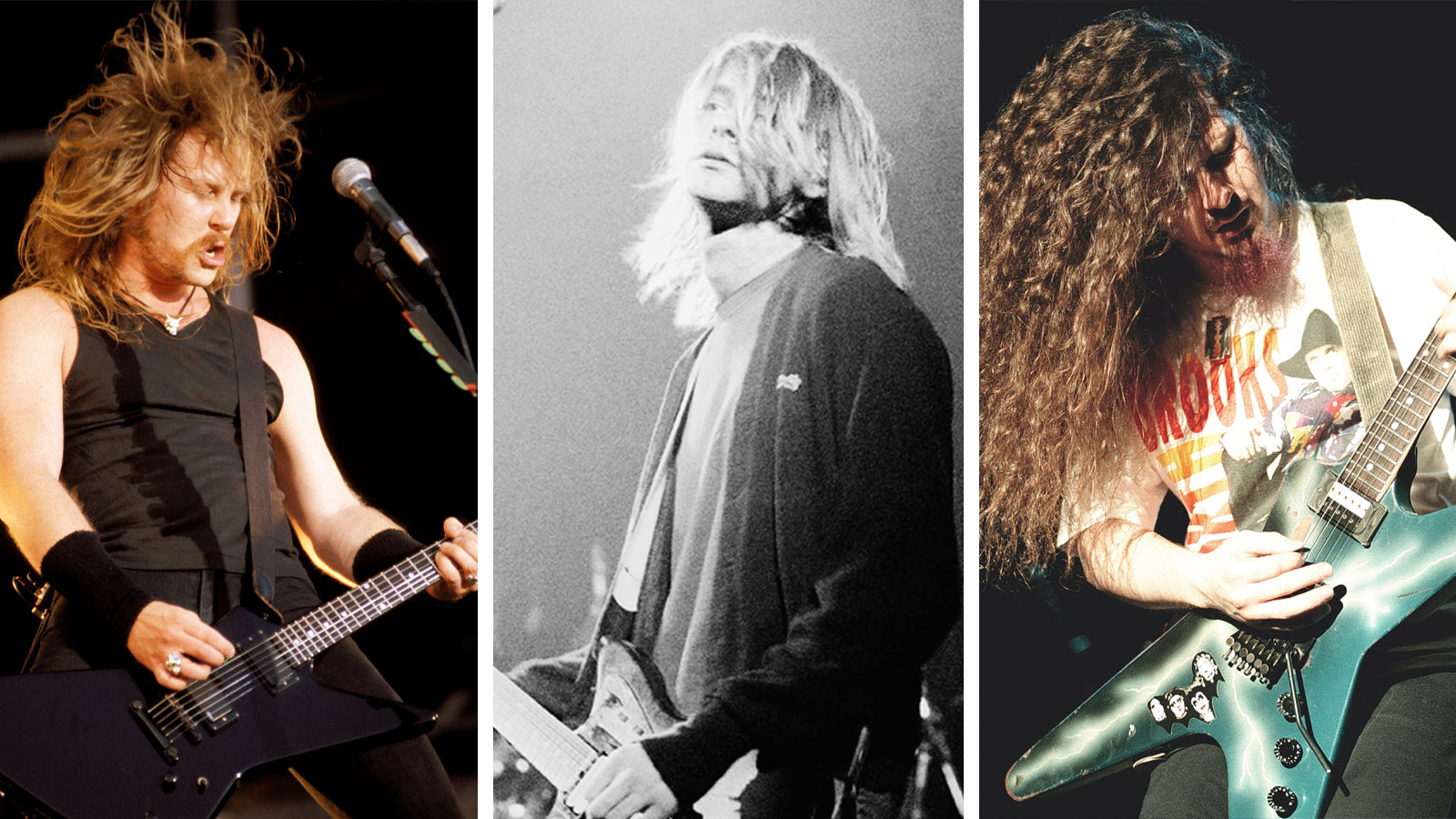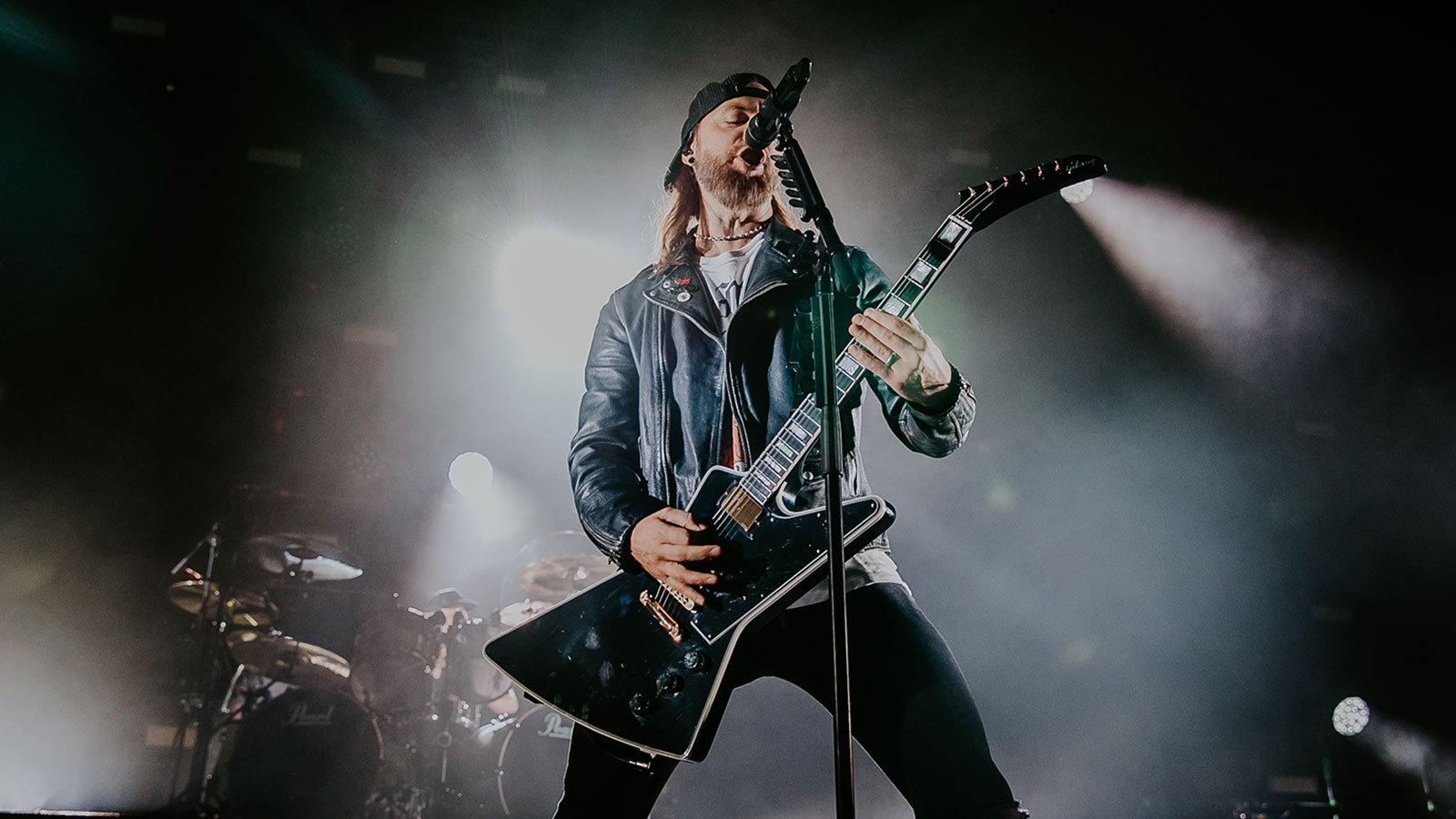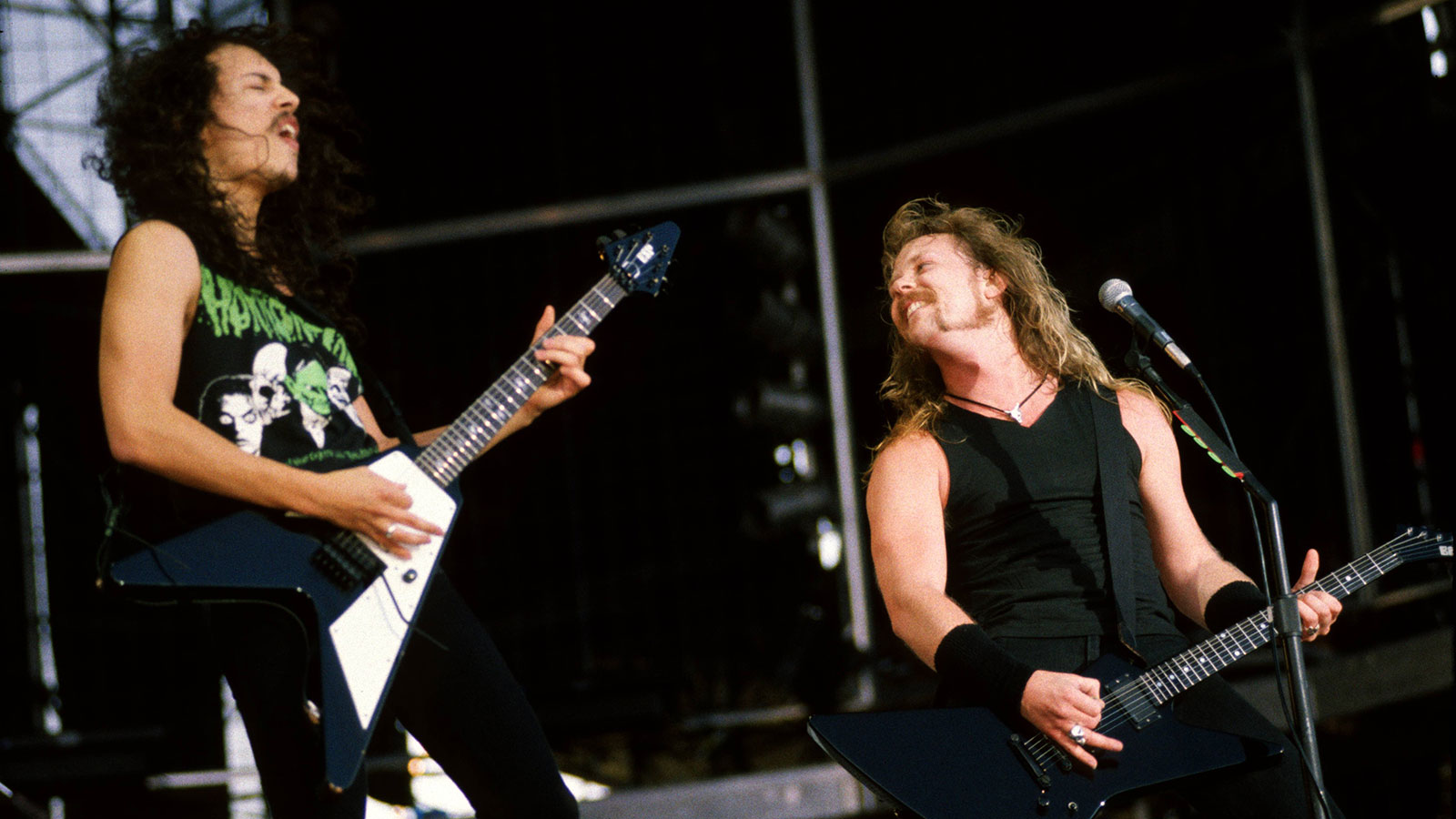The greatest guitar albums of the '90s
From Pearl Jam to Pantera, Metallica to Morello

- 10. Red Hot Chili Peppers – Blood Sugar Sex Magik (1991)
- 9. Tool – Ænima (1996)
- 8. Soundgarden – Superunknown (1994)
- 7. Pantera – Vulgar Display Of Power (1992)
- 6. Alice In Chains – Dirt (1992)
- 5. Megadeth – Rust In Peace (1990)
- 4. Rage Against the Machine – Rage Against the Machine (1992)
- 3. Nirvana – Nevermind (1991)
- 2. Pearl Jam – Ten (1991)
- 1. Metallica – Metallica (1991)
Back in May, Total Guitar conducted a series of polls on GuitarWorld.com. A staggering number votes were cast – just over 150,000, in fact – and now the results can be revealed.
Because we wanted to represent every era, from early classics to contemporary guitar heroes, we divided up our polls decade by decade from the 1960s all the way through to the 2010s and 2020s. Here, we present the top 10 guitar albums of the '90s, as voted by you.
Throughout the '90s, heavy music was redefined by Rage Against the Machine, Pantera, Soundgarden and more. But incredibly, four of the decade’s greatest guitar albums were released within a six-week period in 1991.
10. Red Hot Chili Peppers – Blood Sugar Sex Magik (1991)
Leaning harder into the funk of funk-rock than any of their peers, the Chilis’ defining moment finds John Frusciante drawing as much on Parliament-Funkadelic and Sly Stone as Hendrix.
It turned out that playing James Brown riffs with a grittier tone and a drummer who wanted to be John Bonham was a winner. Frusciante’s angular soloing on Suck My Kiss and the graunching string bends of Give It Away explored how percussive lead guitar can get, while Under The Bridge is the best anyone has appropriated Hendrix’s combined lead-rhythm style. Amps? You don’t need one – John did most of this straight into the desk.
9. Tool – Ænima (1996)
Unlike his former bandmate Tom Morello, there’s no single aspect of Tool guitarist Adam Jones’ playing that is identifiably unique. Somehow, though, the overall effect sounds quite unlike anyone else. The majority of riffs are in 4/4, but the band’s knack for placing accents in different places for each instrument makes Ænima constantly rhythmically engaging.
Jones’ Les Paul tone is gigantic yet clear, coming from an early blueface Diezel VH4. His use of flangers gave the tone movement, and he’s one of the few guitarists to exploit his guitar’s tone control. The grooves in Ænima are so hypnotic that epic tunes flash by.
Get The Pick Newsletter
All the latest guitar news, interviews, lessons, reviews, deals and more, direct to your inbox!
8. Soundgarden – Superunknown (1994)
For all the success of Superunknown, a number one in the US, Soundgarden’s fourth album saw fearless experimentation with time signatures. Spoonman is in 7/4, My Wave in 5/4, and Limo Wreck in a head-spinning 15/8 (five ‘triplet’ beats per bar). Their wild tunings included Open C (C-G-C-G-G-E), and Open E5 (E-E-B-B-B-B).
Nevertheless, MTV found Black Hole Sun irresistible. Chris Cornell and Kim Thayil somehow retained clarity amid such sludgy riffing, thanks in no small part to Cornell’s choice of a Gretsch Duo Jet and Silver Jet and a Fender Jazzmaster to record all the rhythms, split through a Mesa/Boogie Dual Rectifier and 50-watt Marshall JMP.
7. Pantera – Vulgar Display Of Power (1992)
Dimebag Darrell was one of metal’s great characters – Zakk Wylde and EVH mashed into one fret-melting force of nature. On paper, Pantera should have been too heavy to get as big as they did, but Dime’s riffs had such an irresistible groove that everyone got on board. His vibrato was wider than the Grand Canyon, and his chromatic licks were vicious.
The 12/8 rhythm of Walk defines groove metal, and its hand-crossing tapping lick is just plain fun. Dime proved you didn’t need valve amps for brutality, either. His preferred Randall solid-state heads grind with an unceasing fury here.
6. Alice In Chains – Dirt (1992)
Riffing harder than any of their Seattle contemporaries, Alice In Chains brought metal and grunge fans together. Them Bones successfully turned a piledriving riff in 7/8 into a hit single without sounding remotely prog, and Cantrell’s drop D grinding and layered parts earned him the admiration of Dimebag Darrell and Eddie Van Halen.
Producer Dave Jerden recorded a separate amp for each EQ band. A Rockman supplied the treble, and a Bogner Ecstasy brought the mids. Bass was either a prototype Dual Rectifier or a Bogner Fish preamp, depending who you ask, but either way the resulting tone is colossal.
5. Megadeth – Rust In Peace (1990)
Marty Friedman’s choice soloing made Megadeth the guitar connoisseur’s favourite thrashers, and he was never in better form than on Rust In Peace. With exotic pentatonic scales and artfully chosen ‘wrong’ notes, he never sounded predictable but he kept enough blues influence to be accessible.
Standouts like Tornado Of Souls show a vibrato Kirk Hammett could only dream of and a perfect balance of technique and melody. Dave Mustaine isn’t outclassed either – his ‘machine gun’ alternate picking is blistering. He delivered his best riffs and songs to date, and went toe-to-toe with Friedman for Hangar 18’s duelling solos.
4. Rage Against the Machine – Rage Against the Machine (1992)
There’s a lot to say about Rage Against the Machine’s musical innovation, but ultimately every landmark album needs great songs, and Rage had ’em. Their debut had the best set of Jimmy Page-inspired blues riffs since Led Zeppelin II, and frontman Zack de la Rocha created slamming hooks without the need for singing. Drummer Brad Wilk had a Bonham-esque ability to hit each snare slightly late and guitarist Tom Morello also sat behind the beat, sounding like a T-Rex stomping through New York.
Morello had an astonishingly creative mind and a refusal to be limited by conventional approaches
Morello’s preference for neck pickup tones on rhythms made him stand out. He used his Arm the Homeless guitar for standard tuning and American Standard Telecaster for everything in drop D, with overdubs from a Les Paul.
Sick of tone chasing, Morello picked one amp setting in rehearsal and has stuck with it ever since. Luckily, his Marshall 2205 sounded awesome. Innovation is part luck, and Morello happened to be the first breakthrough guitarist with a DigiTech Whammy. But he also had an astonishingly creative mind and a refusal to be limited by conventional approaches.
His DJ scratching, created with a killswitch and a wide-open wah pedal, was brand-new. At times he’d unplug the guitar and exploit the noises made by a live cable. Somehow, Tom made it all work in context without sounding weird for the sake of it.
3. Nirvana – Nevermind (1991)
The ’90s didn’t really begin until Nevermind came out. There had long existed a punk scene for people who felt alienated by bands like Mötley Crüe. By 1991, that was the majority, and a generation embraced Nirvana for rejecting what had gone before.
Audiences connected to Cobain’s raw emotion, but they might not have done so in such numbers had Vig not persuaded him to multitrack a slick wall of guitars
Kurt Cobain had bought his Fender Jaguar because it was the only decent lefty he could find, but it helped that it looked unlike anything on MTV. Where ’80s chorus had been digitally pristine, Kurt chose an analogue MXR Small Clone. Where their distortion had come from giant amps, Kurt had a $40 Boss DS-1. And where they had shredded, Kurt played the vocal melody.
Ironically, producer Butch Vig didn’t let Nirvana sound the way they wanted. Nevermind’s sonics reflect the tension between Kurt’s urge for rawness and Vig’s radio-friendly instincts. Audiences connected to Cobain’s raw emotion, but they might not have done so in such numbers had Vig not persuaded him to multitrack a slick wall of guitars.
Beyond the sonics were Kurt’s immaculately crafted songs. The soft-loud dynamics were undeniably effective, and he had a Beatles-like knack for unexpected but satisfying chord changes. Lithium dances between D major and D minor for its verse and changes key for the chorus, while In Bloom somehow weaves a beautiful melody around the most jarring set of chords.
It’s hard to think about Nevermind without thinking of the overall tragedy of Kurt’s life, but it’s a monumental testament to the power of music – and guitars – to communicate feeling.
2. Pearl Jam – Ten (1991)
Stone Gossard and Mike McCready’s smart approach to having two guitars gave Pearl Jam’s debut its expansive sound. Generally McCready plays a Strat while Gossard plays a Les Paul, and one plays high while the other plays low. The distinct tones and frequencies from each guitarist give everything clarity and fill the entire audio spectrum with sonic excitement.
Pearl Jam were reconnecting rock with more organic tones and blues-rock roots, more Hendrix than hair metal
Pearl Jam have been called Seattle’s Rolling Stones to Nirvana’s Beatles. Like the Stones they have the knack of “weaving sonic tapestries”, as Keith Richards put it. Their thoughtful part writing also left space for Jeff Ament’s enormous 8- and 12-string basslines.
Mike McCready’s undisguised Stevie Ray Vaughan passion saw him bring Strats back into vogue. After a decade of compressed humbucker tones, McCready’s dynamic single coils underlined that this was a new generation.
He described his playing on Black and Even Flow as an SRV “rip off”, while he saw the epic outro solo in Alive as a copy of Ace Frehley’s solo in She by Kiss, which in turn was taken from Robby Krieger’s Five To One with The Doors.
Both guitarists used JCM800s for dirty tones and Fenders for clean parts. The guitarists happily shared the spotlight, with Gossard often playing main riffs on songs where McCready took solos.
Kurt Cobain may have sneered that Ten had too many solos for an alternative band, but Pearl Jam were reconnecting rock with more organic tones and blues-rock roots, more Hendrix than hair metal. Ten was a classic rock masterpiece disguised as a grunge album.
1. Metallica – Metallica (1991)
The standout guitar album of the ’90s. The best-selling heavy metal album of all time. A sonic and creative benchmark for the genre. Metallica’s self-titled fifth album, forever known as The Black Album, is also the inspiration for countless young guitarists, with lead single Enter Sandman an essential riff for every new player. And for Matt Tuck, leader of British metal stars Bullet For My Valentine, the influence of this album is profound.
“They were a big band before that anyways,” Matt says, “but as soon as they released The Black Album it went stratospheric. They’ve been untouchable ever since, as far as getting an album to connect with as many people as they did. The amount of sales, how relevant it is 30 years later – it’s just a phenomenon!”
I started to learn to play guitar by myself that year, off the back of that album
Matt Tuck
Tuck tells a story millions of metal fans can relate to: “I was 14 years old. We had just got Sky installed so we had MTV. We put it on and there was this music video on of a truck smashing through a man’s bed, with all these crazy low-end toms raging. It was Enter Sandman. The moment I heard it I was like ‘What the fuck is this?’ I was hooked from that moment. Within a couple of weeks I went out and bought my first ever album, Metallica’s Black Album.”

In that moment, Matt Tuck’s future was set. “I started to learn to play guitar by myself that year, off the back of that album,” he continues. “I learned some basic chords, then put on that album and started to work it all out. I wanted to be James Hetfield!”
In the early ’80s, Metallica had risen to cult status as pioneers of thrash metal, a super-fast, super-heavy hybrid of metal and punk. After a doggedly anti-commercial start to their career, they had made their first MTV video, for the song One, in 1988.
The following album would be a risky move into the mainstream. For this, they enlisted producer Bob Rock, best known for working with Mötley Crüe and Bon Jovi. James Hetfield’s touring guitar had long been emblazoned with a “Kill Bon Jovi” sticker, and some Metallica fans were nervous.

Rock was famously demanding in the studio. Tensions between band and producer are visible in the Year In The Life Of Metallica documentary, and there were times during the making of the album when band and producer were barely on speaking terms.
Matt Tuck compares the process to working with producer Don Gilmore (Linkin Park) on Bullet’s 2010 album Fever. “We’ve never had that kind of ascendancy,” he says, “but Fever felt like a big stepping stone for us. That took us from Brixton Academy to Wembley. Up until that point, nobody questioned the songwriting. Don Gilmore was the only guy that really challenged me as a writer and I didn’t like it! He’s trying to get us to take out double kick patterns and not dumb it down, but just try and make it a little bit more Black Album.”
Matt can understand Metallica’s difficulties with Rock. “It’s such an intimate long-term personal process. The first time you work with these guys you don’t know them, there’s no relationship, there’s no trust. It’s only really when the dust settles and you can look back on it a couple of years later that you actually appreciate the process.”
The Black Album’s monochrome cover both earned its nickname and invited comparisons to AC/DC’s Back In Black... the connection was conscious
The Black Album’s monochrome cover both earned its nickname and invited comparisons to AC/DC’s Back In Black. The albums have more in common than just their ultra-noir sleeves. Both were made at the turn of a decade by bands in mourning (AC/DC for singer Bon Scott, Metallica for bassist Cliff Burton).
Both bands had begun with cult followings and made steps towards the mainstream with Highway To Hell (1979) and ... And Justice For All (1988) respectively. For both bands, though, black albums marked the leap to global stardom, securing their places in the rock pantheon – even if diehard fans still prefer their earlier work.
The AC/DC connection was conscious. Drummer Lars Ulrich told Uncut magazine’s John Robinson in 2020 that they listened to the Australians when writing The Black Album: “We thought about the art of simplifying and writing shorter songs... A little more bounce, to make the music more physical than cerebral.”
Where Metallica’s trademark in the ’80s had been fast and furious, AC/DC often made songs heavier by slowing down.
The Black Album was notable for establishing scooped mids as the dominant metal guitar tone. The main rhythm amp was a Mesa/Boogie Mark II-C++ as it had been since Master Of Puppets, but a modded Marshall JCM800 and a Boogie Mark V were among the other amps to hand.
On Hetfield’s Mesa, mid control was at 0 and the amp’s graphic EQ was a shaped in a V, with the middle 750Hz band all the way down at -12dB. There were two further parametric EQs in the FX loop, cutting mids at 900Hz and 1.2kHz and boosting presence at 4.2kHz and 6kHz. By now, Metallica were using ESP guitars with EMG pickups.
It was directly the opposite of classic mid-heavy tones from bands like Black Sabbath and Iron Maiden, but Metallica did strategically replace some of the lost mids with the Marshall amp. Rock’s JCM800 was modified by Jose Arredondo, famous because Eddie Van Halen had claimed (falsely, it later emerged) he had modded Ed’s famous Plexi.
They’re the most important metal band there’s ever been, and The Black Album deserves every accolade. They are the kings
Matt Tuck
“James wanted crunch,” Bob Rock told Reverb.com. “Crunch to me is upper mids. Crunch to him is that resonance when he palm mutes and it goes gonk! It’s the sound of the room we made for the guitar sounds, it’s not all close mic’ed.”
Rock’s input on the guitars was huge. He suggested they tuned down to D standard for Sad But True after noticing all the songs were in the same key. He pushed Kirk to try harder on solos, insisting on him laying down an improvised solo with every live take of each song.
When lead guitarist Kirk Hammett recorded the final solos, they used the improvised takes for inspiration. Rock rejected Kirk’s initial idea for The Unforgiven, and suggested Kirk fingerpick the clean half of the solo – “really pull on the strings and slap them against the frets,” as Kirk recalled to Guitar World. His insistence paid off and Kirk can be seen grinning in A Year In The Life...
“It’s pretty much the type of guitar solo I’ve been trying to do for the last five or six years,” he said, “and I’m really proud of that.”
It was also Rock who gave James the confidence to pursue the ballad Nothing Else Matters, notable for Hetfield’s first Metallica solo. The Black Album forever positioned Metallica as metal giants. And for Matt Tuck, is still stands tall as a masterpiece.
“We’ve managed to play a few festivals and shows with Metallica,” Matt smiles. “It’s always a bit of a headfuck, I’m not gonna lie. They’re such a huge part of my life from such an early age and they’ve defined me as a person and my career. It’s as big as that for me. So for them to pass me in the corridor at a festival and go, ‘Hey, Matt!’ just blows my mind. They’re the most important metal band there’s ever been, and The Black Album deserves every accolade. They are the kings.”
Jenna writes for Total Guitar and Guitar World, and is the former classic rock columnist for Guitar Techniques. She studied with Guthrie Govan at BIMM, and has taught guitar for 15 years. She's toured in 10 countries and played on a Top 10 album (in Sweden).










